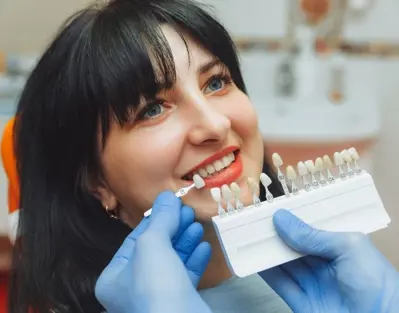
There is so much information and advertising about ways to whiten your teeth it can be hard to know what is best.
Your dentist is your guide to navigating teeth whitening treatment safely and effectively. Here are 4 reasons why you should see a dentist to help guide your decision.
1. Diagnose the cause of the discolouration, and any other tooth, gum or mouth problems.
There are many reasons teeth can become stained and discoloured and there are different ways to treat these causes. It is important to know the reason for the discolouration and make a change to prevent it from happening again. If you don't make a change, the whitening treatment may not be effective long-term.
The stains may only be on the outside surface of the teeth. Possible causes include:
- foods such as spices
- mouth bacteria
- smoking
- drinking tea, especially black and green tea without milk.
A professional dental clean may be needed to remove these stains.
Discolouration inside the tooth can be caused by:
- tooth decay
- a problem with the dental pulp
- old fillings
- conditions affecting the teeth while they are developing.
These conditions all need treatment by a dentist. Tooth whitening alone won’t improve these conditions.
2. Check if whitening is the right treatment for you
Tooth whitening has risks and there are some potential side effects to be aware of.
Tooth sensitivity is common. It is usually temporary and minor but if you have untreated tooth decay, it can be more severe. Your dentist can explain how you might be affected and how to manage the sensitivity.
If your tooth discolouration is stubborn or you would like to try and lighten the teeth further, you may need whitening more than once. It is best to do this following advice from a dentist who can also monitor your treatment. If you want to also change the shape or position of your teeth, you may need to look at treatments such as veneers, crowns or teeth straightening.
Tooth whitening treatment will not change the colour of fillings and crowns. Whitening your teeth where some teeth have crowns or fillings may cause the colour of your teeth to not match. These treatments may need to be redone to match the new teeth colour. It is important to know which teeth might be affected before starting whitening treatment and if you may need extra treatment so all your teeth will match.
3. Full range of options, including properly fitted custom home whitening trays
Only your dentist is trained to give you the full range of options when it comes to tooth whitening. Options can include:
- Professional teeth cleaning and suggesting products to use at home.
- Take-home whitening treatment where custom dental trays with whitening gel are used at home. It may be tempting to buy a DIY kit from the chemist or online, but if the tray does not fit well, the whitening gel may flow unevenly and contact the gums, causing discomfort. Custom trays are often thinner and more comfortable to wear.
- Tooth whitening in the dental clinic using higher strength tooth whitening products.
4. Start with a clean slate, and a plan
Your health is most important, so get a check-up and treat any dental and mouth problems first. Ignoring these problems will lead to pain and more complex, expensive treatment later on.
Whitening works better on a clean tooth surface, so a professional dental clean may be needed before starting teeth whitening treatment. Sometimes this is enough for a great result!




